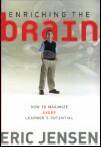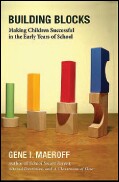Brain Research

Drawing from research on neuroscience, intelligence, genetics, and child development, Jensen, a former teacher, outlines a strategy for improving children’s cognitive powers that he predicts can aid over 90 percent of all students, from those with special needs to the gifted. Arguing against the notion that brain capacity is genetically determined, he asserts that schools and parents can reshape students’ brains through actions such as providing novel and challenging learning activities, teaching stress-management techniques, and promoting good nutrition and physical activity. Conventional schooling, with its emphasis on standardized testing, runs counter to brain-enrichment research, Jensen writes, and can actually cause children’s intelligence to regress. He suggests that schools instead create a customized education program for every student, and gives concrete advice on how such a change could be implemented schoolwide and at the classroom level.
An introduction to neurobiology that highlights the science’s practical applications for teachers.
A guide to improving students’ mental focus, sustaining their attention, and boosting their memory, written from the perspective of a medically trained neuroscientist turned educator.
Early Education

Citing the significance of the primary grades as a foundation for later student achievement, Maeroff, a senior fellow at the Hechinger Institute on Education and the Media, at Teachers College, Columbia University, calls on educators and policymakers to adopt a prekindergarten-through-3rd-grade approach to early education. Such a configuration, he explains, would not only ensure that this age group receives the attention it deserves, but could also enhance young children’s learning by fostering coordination within and across grade levels, providing a solid grounding in literacy, and allowing for staggered rates of development through varied student groupings. Maeroff further recommends that, within the pre-K-3 setting, preschool be made available to all 4-year-olds (and, eventually, 3-year-olds), and that every district offer full-day kindergarten. Case studies from across the nation enliven the text and illustrate the challenges and successes of a pre-K-3 structure.
The father of Head Start and colleagues from across the social sciences spell out the requirements of a model preschool program.
Sports

Cuadros, a freelance reporter, moved to rural North Carolina in 1999 to investigate the Southeast’s burgeoning Hispanic population connected to the poultry-processing industry. A former high school soccer player, he soon took up the cause of Latino students at Jordan-Matthews High School in Siler City, who for years had unsuccessfully petitioned school administrators for a soccer team. After several months, Cuadros obtained permission to establish a program—no small feat in a town devoted to its football team, and which had hosted an anti-immigrant rally the previous year. In this book, he recounts the soccer team’s formation and first three seasons, culminating in its 2004 state championship. Cuadros’ descriptions of the predominantly Hispanic players shed light on the struggles faced by immigrant students, but his message ultimately is one of hope as he relates how a team that was jeered during its first season became, through its championship run, a unifying force for the entire community.
A critical assessment of the competitive frenzy youth baseball has become, and of the adults who feed it.
Born without legs, high school wrestling star Jenifer tells how he overcame adversity, both in athletics and in the rest of life.
Youths and the Law

The presiding judge of a Manhattan juvenile court, Corriero contends that laws which require teenagers charged with serious crimes to be tried as adults, and which restrict judicial discretion in sentencing for such cases, are unjust and ineffective. He says that those policies ignore developmental differences between adolescents and adults by holding young offenders to a level of maturity they do not possess, and that such laws are unsuccessful in deterring crime. Pointing to teenagers’ greater openness to rehabilitation, he describes a juvenile-justice system that could identify youths capable of addressing their problems without compromising public safety. Under his plan, such adolescents would be placed in “alternative to incarceration” programs that would enable them to receive counseling, continue their education, and pursue employment. Such a system, he concludes, could satisfy society’s need for protection from criminals while putting juvenile offenders on the right track to becoming productive members.
***************************************
Also of Note
A scholar looks at early schools and finds the roots of modern education.
A defense of the theory of evolution by a leading authority on the subject.
Scientific, legal, educational, and religious experts speak to teachers and parents in this collection of essays.
A journalist finds emotional healing through his relationship with the children’s television icon.
Life lessons interspersed throughout a puppeteer’s account of how he traveled from an African-American neighborhood outside Baltimore to “Sesame Street.”
A compendium of the Appalachian folk-life wisdom collected since Georgia high school students created a magazine—and a movement—called Foxfire in 1966.
From a Pulitzer Prize-winning author, a look at the legislation behind the “greatest generation.”
A physicist and a psychologist team up to explain why reform movements fail.
Catholic schooling, modern language, and famous authors’ grammar are all dissected in this lighthearted eulogy for the word-mapping method.


